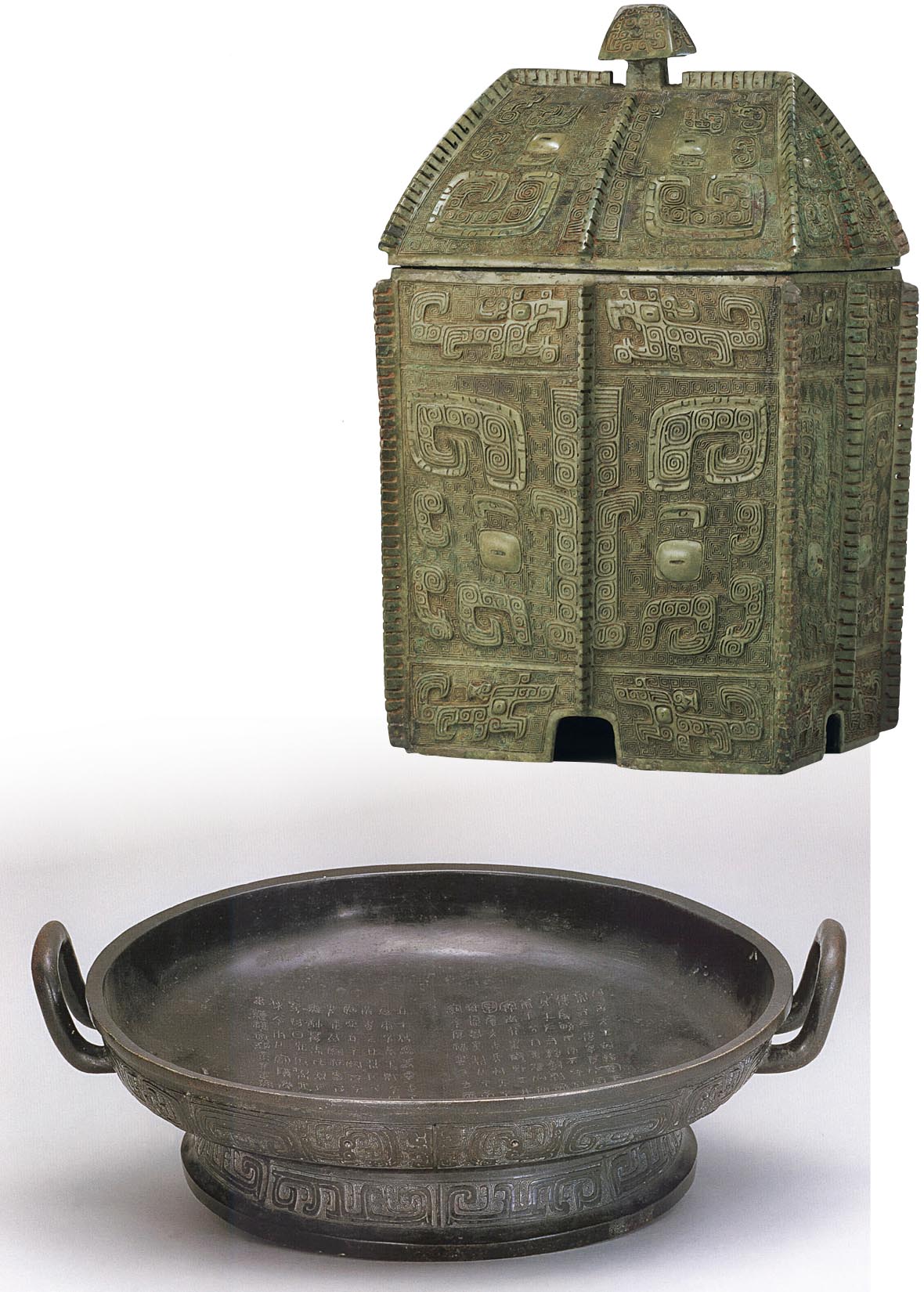Bronze Metalworking

Bronze Vessels The Shang Dynasty bronze vessel on the top, dating to the twelfth century B.C.E. and about 10 inches tall, is covered with symmetrical animal imagery, including stylized taotie masks. The early Zhou Dynasty inscribed bronze pan (bottom), dating to before 900 B.C.E., was one of 103 vessels discovered in 1975 by farmers clearing a field. The inscription tells the story of the first six Zhou kings and of the family of scribes who served them. (pan: Shanxi Zhou Yuan Museum/Uniphoto Press, Japan/Ancient Art & Archeology Collection, Ltd.; taotie vessel: Ritual Wine Container with Cover (Fangyi). China, Shang Dynasty (ca. 1600–1046 B.C.E.), 12th century B.C.E. Bronze. Purchase, Arthur M. Sackler Gift, 1974 [1974.268.2a, b]/The Metropolitan Museum of Art, New York, NY, USA/Image copyright © The Metropolitan Museum of Art/Image source: Art Resource, NY)
As in Egypt, Mesopotamia, and India, the development of more complex forms of social organization in Shang China coincided with the mastery of metalworking, specifically bronze. The bronze industry required the coordination of a large labor force and skilled artisans. Bronze was used more for ritual than for war in Shang times. Most surviving Shang bronze objects are vessels such as cups, goblets, steamers, and cauldrons that would have originally been used during sacrificial ceremonies. They were beautifully formed in a great variety of shapes and sizes.
The decoration on Shang bronzes seems to say something interesting about Shang culture, but scholars do not agree about what that is. In the art of ancient Egypt, Assyria, and Babylonia, representations of agriculture (domesticated plants and animals) and of social hierarchy (kings, priests, scribes, and slaves) are very common, matching our understandings of the social, political, and economic development of those societies. In Shang China, by contrast, images of wild animals predominate. Some animal images readily suggest possible meanings. Jade cicadas were sometimes found in the mouths of the dead, and images of cicadas on bronzes are easy to interpret as images evocative of rebirth in the realm of ancestral spirits, as cicadas spend years underground before emerging. Birds, similarly, suggest to many the idea of messengers that can communicate with other realms, especially realms in the sky. More problematic is the most common image, the stylized animal face called the taotie (taow-tyeh). To some it is a monster — a fearsome image that would scare away evil forces. Others imagine a dragon — an animal whose vast powers had more positive associations. Some hypothesize that it reflects masks used in rituals. Others associate it with animal sacrifices, totemism, or shamanism. Still others see these images as hardly more than designs. Without new evidence, scholars can only speculate.
Bronze technology spread beyond Shang territories into areas the Shang would have considered enemy lands. In 1986, in the western province of Sichuan, discovery was made of a bronze-producing culture contemporaneous with the late Shang but very different from it. Two sacrificial pits contained the burned remains of elephant tusks and a wide range of gold, bronze, jade, and stone objects. Among them were life-size statues and many life-size bronze heads, all with angular facial features and enormous eyes. No human sacrifices were found, leading some scholars to speculate that the masks were used to top wood or clay statues buried in place of humans in a sacrificial ceremony. Archaeologists are continuing to excavate in this region, and new discoveries are gradually providing fuller understanding of the religion of the people who lived there.
